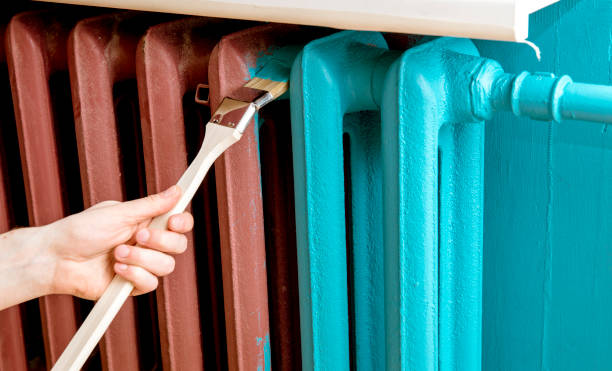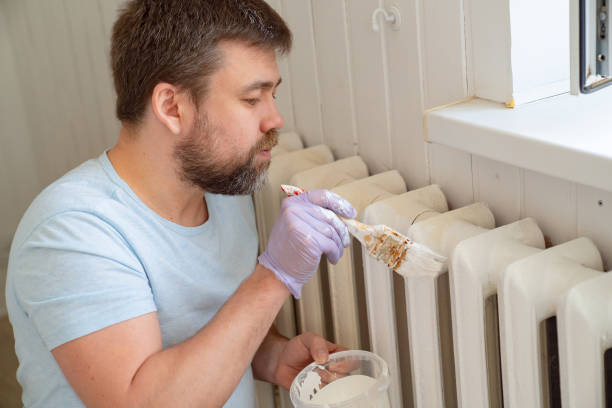Mastering The Art Of Residential Painting: Pro Tips For Painting House Radiators
Painting house radiators is an essential part of maintaining the appearance of a residential property. Radiators, whether old or new, can start to look dull and outdated over time. Repainting them can help breathe new life into the room and make the space look more inviting. However, painting radiators requires more than just a coat of paint. It requires some skill and knowledge to ensure the job is done correctly, which is why it is essential to master the art of residential painting.
This article provides pro tips for painting house radiators, from choosing the right type of paint to the finishing touches and maintenance. The tips outlined in this article are designed to help homeowners carry out the job safely, effectively, and with a professional finish. By following these tips, homeowners can give their radiators a new lease of life and create a fresh look for their living spaces.
Choose the Right Type of Paint
Selecting the appropriate paint type is a crucial step in ensuring a durable and long-lasting finish for your household heating elements. When it comes to painting radiators, it is essential to choose high-temperature paint that can withstand the heat generated by the heating system. High-temperature paint is specifically designed to handle extreme temperatures, and it can withstand temperatures of up to 1200°F. This type of paint is perfect for radiators as they generate a lot of heat.
Another factor to consider when choosing the right type of paint is the surface of the radiator. A radiator's surface can be made of various materials such as cast iron, steel, or aluminum. Each of these materials has different paint requirements. For instance, cast iron radiators require oil-based paints that can adhere well to the surface and prevent rusting. On the other hand, aluminum radiators require acrylic-based paints that can resist peeling, cracking, and chipping. Therefore, it is crucial to identify the type of surface before selecting the appropriate paint type.

Prepare Your Radiator for Painting
In order to prepare your radiator for painting, it is crucial to clean the surface thoroughly. This means removing any dirt, dust, or debris that may be present. Additionally, sanding the surface can help to create a smooth and even surface for the paint to adhere to. Finally, applying a primer can help to ensure that the paint will stick to the surface and provide a long-lasting finish. These steps are essential for achieving a professional-looking paint job on your radiator.
Clean the Surface Thoroughly
Thoroughly cleaning the surface of a radiator before painting is essential to ensure proper adhesion and a smooth, professional-looking finish. The first step in cleaning a radiator surface is to remove any loose debris or chipping paint using a scraper or wire brush. Once the loose debris has been removed, the surface should be wiped down with a damp rag to remove any remaining dirt or grime.
After the initial cleaning, it is important to remove any rust or corrosion from the surface. This can be done using a rust remover or sandpaper. Any remaining rust or corrosion can cause the paint to bubble and peel, leading to an uneven finish. Once the surface has been thoroughly cleaned, it should be allowed to dry completely before painting. Taking the time to properly clean the radiator surface will ensure that the paint adheres properly and that the finish is smooth and professional-looking.
Sand and Prime the Surface
Sandpaper should be used to remove any remaining rust or corrosion and a primer should be applied to the surface before painting in order to ensure proper adhesion and a long-lasting finish. Sanding the surface with fine-grit sandpaper allows for a smooth and even finish, while also removing any dirt, grime, or loose paint that may have accumulated over time. This is crucial as any imperfections left on the surface can compromise the quality of the final coat of paint. Once the surface has been sanded, it is important to clean it thoroughly to remove any dust or debris that may have been left behind.
After sanding and cleaning the surface, applying a primer is the next step to achieving a professional-looking finish. Primer acts as a base coat, providing a smooth and even surface for the paint to adhere to. It also helps to seal the surface, preventing any moisture from seeping into the metal and causing rust or corrosion. Choosing the right primer is important, as there are different types available for different surfaces and conditions. For example, a rust-inhibiting primer is recommended for surfaces that have a lot of rust or corrosion. Applying primer also helps to reduce the number of coats of paint needed to cover the surface, saving time and money in the long run. Overall, sanding and priming the surface are crucial steps in achieving a flawless finish and ensuring the longevity of the painted surface.
Use the Right Tools and Techniques
Effective utilization of appropriate tools and techniques is imperative for achieving optimal results when painting radiators in residential settings. The first step is to choose the right type of brush. Since radiators are usually small and have many crevices, a brush with a small head and long handle is recommended. This type of brush allows for better control and precision when painting hard-to-reach areas. It is also important to use a high-quality brush made with natural bristles that can hold more paint and provide a smoother finish.
Another important consideration when painting radiators is the type of paint to use. Oil-based paint is generally preferred for its durability and resistance to heat. However, it is essential to use a paint that is specifically designed for radiators to ensure that it can withstand the high temperatures that radiators generate. Additionally, it is crucial to use a paint that is both heat-resistant and non-toxic to avoid any potential health hazards. By using the right tools and techniques, homeowners can achieve a professional-looking finish on their radiators that will last for years to come.
Ensure Proper Ventilation and Safety Measures
In addition to using the right tools and techniques, ensuring proper ventilation and safety measures is crucial when painting house radiators. Painting can release harmful fumes that can cause health hazards if inhaled, and poor ventilation can exacerbate the problem. Therefore, before starting the painting project, it is essential to ensure adequate ventilation in the room. If possible, open windows and doors to let fresh air in and fumes out. You may also use fans or air purifiers to improve air circulation and reduce fumes' concentration.
Another important safety measure to consider is personal protective equipment (PPE). PPE can protect your skin, eyes, and respiratory system from paint fumes and other hazardous materials. It includes gloves, goggles, respirators, and coveralls. When choosing PPE, make sure it is appropriate for the type of paint you are using and that it fits properly. Remember to follow the manufacturer's instructions for use and disposal of PPE. By taking these precautions, you can ensure a safer and healthier painting experience.

Finishing Touches and Maintenance
To ensure the longevity and efficiency of your newly painted radiators, it is important to follow proper finishing techniques and establish a maintenance routine. Once the paint has fully dried and cured, add a layer of clear coat or enamel to protect the surface from scratches and rust. This will also make it easier to clean the radiators in the future. Be sure to use a high-quality brush and follow the manufacturer's instructions for application and drying time.
In terms of maintenance, it is important to regularly clean the radiators to prevent dust and debris buildup, which can impact their performance. Use a soft cloth or brush to gently remove any dirt or dust from the surface. It is also recommended to check the valves and pipes for leaks or damage periodically. If you notice any issues, contact a professional to address them promptly. By following these finishing and maintenance tips, you can extend the life of your painted radiators and ensure they continue to operate efficiently.
Conclusion
In conclusion, painting a house radiator can be a challenging task, but with the right tools, techniques, and safety measures, you can achieve a professional-looking finish. It is essential to choose the right type of paint that can withstand high temperatures and adhere well to metal surfaces. Proper surface preparation, including cleaning and sanding, is critical for a successful paint job. Additionally, using the right tools and techniques, such as using a brush or spray gun, can ensure a smooth and even application.
Ventilation and safety measures, such as wearing protective gear and ensuring proper airflow, are essential when painting radiators. It is also crucial to apply finishing touches, such as removing any drips or smudges, to ensure a clean and polished appearance. Lastly, regular maintenance, such as cleaning and touch-ups, can help prolong the life of your newly painted radiator. With these pro tips in mind, you can master the art of residential painting and take on any painting project with confidence.
If you're interested to have more knowledge about this topic, feel free read this blog post from Patch and Paint Pros.

